
Copyright 2014 by Bobby Mercer
All rights reserved
First edition
Published by Chicago Review Press, Incorporated
814 North Franklin Street
Chicago, Illinois 60610
ISBN 978-1-55652-407-3
Library of Congress Cataloging-in-Publication Data
Mercer, Bobby, 1961- author.
The Robot book : build and control 20 electric gizmos, machines, and hacked toys / Bobby Mercer.
pages cm. (Science in motion)
Summary: The 20 easy-to-build robots in this project book can be constructed for little or not cost using common household objects and repurposed materials. Provided by publisher.
Audience: Ages 9+
ISBN 978-1-55652-407-3 (trade paper)
1. RobotsJuvenile literature. 2. RoboticsJuvenile literature. 3. Personal roboticsJuvenile literature. I. Title. II. Series: Science in motion (Chicago Review Press)
TJ211.2.M47 2014
629.892dc23
2014015327
Cover design: Andrew Brozyna, AJB Design, Inc.
Interior design: Rattray Design
Photo credits: Bobby Mercer
Printed in the United States of America
5 4 3 2 1
To Team Science and all the amazing teachers at PCHS.

ACKNOWLEDGMENTS
BOOKS DONT HAPPEN WITHOUT GREAT PEOPLE. Thanks to all the people who helped turn an idea for The Robot Book into a reality. Kathy Green for being a great agent. Jerome Pohlen and the creative people at Chicago Review Press for making it look great.
Thanks to my wonderful family. Michele, you are amazing. Nicole and Jordan, for helping me build most of the activities in this book. Although it is impossible to list them all, a special thanks to all the great people I work with.
CONTENTS
INTRODUCTION
B UILDING ROBOTS SHOULD BE FUN. Hacking old electronics and repurposing them is a start to something more complex. Making robotsor bots for shortshould be a creative and educational experience.
The activities in this book will help you get your feet wet in the robot world. You will learn the basics of electronics and how simple robots function. You will make things move, shake, and walk. Programming and building more complex robots are tasks for the futureyou will have to do much more work before you can create a robot to clean your room or do your homework.
This book starts with simple vibration bots. Vibration bots use motors to make them move. Next, you will learn how to hack old toys and give them new life as your own personal robots. Finally, the book will give you some hints on where to go next if you love robotics.
Science should be fun and rewarding, and experimentation is the key. Always start with a plan, but realize that trial and error also can be valuable. Dont be afraid to modify and change the plans in this book to make your own, unique robots. Have a blast and enjoy.
Now its time to get started!

1

G ETTING S TARTED
W HAT I S A R OBOT ?
A robot is any machine that is designed to do a task. Robots can range from robotic welders to Watson. Robotic welders and other industrial robots repeat the same task thousands of times a day, saving humans from backbreaking labor. Watson is a thinking machine created by IBM that in 2011 beat two of the greatest Jeopardy players of all time.
The word robot was first used in a play by the Czech playwright Karel Capek in 1920. He and his brother derived the word from robota, a Czech word meaning hard work. In his play, the robots looked more like C-3PO than the robots you will be building.
S AFETY
Electricity can hurt you. It needs to be treated with respect. You should always get an adults permission to take apart any electronic device. Explain to the adult what you want to do and what you need from the broken toy, cell phone, toothbrush, or other device. NEVER take apart any electronic device that has a video monitor.
When taking apart anything electronic, even if it is broken, remove the battery. If it has a cord, cut off the cord first.
S OLDERING
Most of the bots in this book can be built using electrical tape for the wire connections. But to make robots more permanent, soldering is a must. Any good future robot builder needs to learn how to solder electrical joints.
Metals conduct electricity. Solder is a soft metal that melts easily with heat. When solder is melted between two exposed wires, it creates a permanent electrical connection. Soldering irons create the heat needed to melt the solder, but they are dangerous. You must get adult help and permission to solder.
Soldering takes practice, and you must follow safety precautions. Read and follow the directions that came with your soldering iron. Never touch the tip of a soldering ironit will be very hot. You should solder only in a well-ventilated area, since the heat creates nasty fumes. Always solder on a surface that is not flammable. Keep paper away from the soldering iron. Many soldering iron kits come with a stand that holds the hot iron. If you are going to do many electronic projects, I highly recommend buying a soldering kit with a stand.
Another great accessory for soldering is a Third Hand to hold your piece in place. A Third Hand is available at any electronics or hobby store. This great device has at least three bendable arms and usually a magnifying glass. You can clip any piece you are working on onto the arms. This gives you two free handsyour handsto hold the solder and the soldering gun.
Make sure you get permission from an adult before soldering. But again, almost all of the bots in this book can be built without using a soldering iron.
W HERE TO G ET P ARTS
This book focuses on simple robots, but youll still need parts to make your robots get up and go. Commercial robot kits are available from LEGO, KNEX, and other sources, but building simple bots using parts you may already have is more exciting.
Never throw out toys, computer parts, or even dead cell phones or toothbrushes without scavenging parts first. (Remember to get adult permission and help before you start taking anything apart.) Save any gears, motors, pulleys, belts, wheels, switches, lights, and battery holders. Also, keep any wire you find. Create a robot junk box for all the cool parts you scavenge.
Electronic toys that no longer work are great sources for parts. A few of the projects in this book use repurposed old toys for bots. You can also find cheap toys at thrift stores that cost less than two or three dollars each. As you take them apart, think about creative uses for their parts.
Even if your toy doesnt match the one shown in a project, you can use it to create your own robot and give it an original name like Jessicas Dazzling Dino-Bot or Max the Motor-Bot.
P ARTS OF A R OBOT
Moving robots need a source of motion, and to create motion, they need a motor. The first several projects in this bookvibration bots and walking botsare powered by simple, small motors. Electric motors are found in many common devices. Dead cell phones are a great source of very small vibration motors. Small hobby motors are found in battery-operated cars. An old computer CD drive has a motor that easily can be powered by a 9V battery. Disposable vibrating toothbrushes also have motors, and many toys have wind-up motors. Of course, you can always buy motors at electronics stores or hobby stores.
Next page

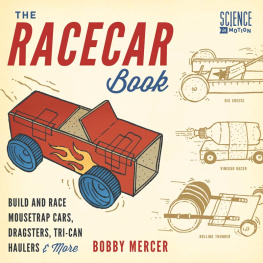



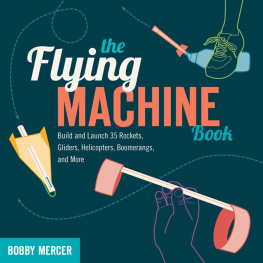


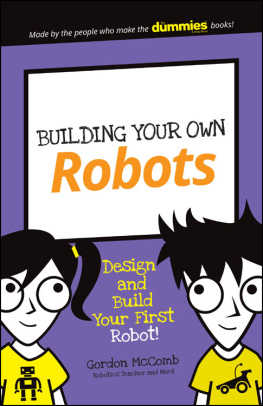
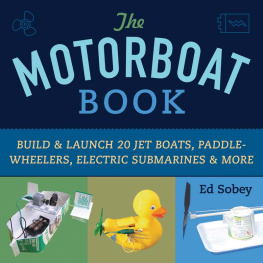
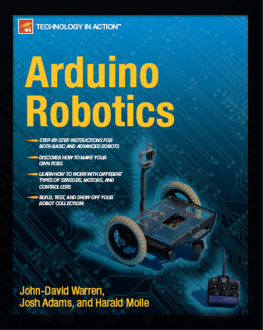


 1
1